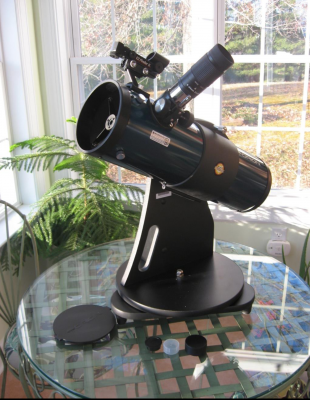Put telescopes in the hands of those who are most interested: The Library Telescope Program
 Many clubs have loaner scopes for their members. The New Hampshire Astronomical Society (nhastro.com), led by its member Marc Stowbridge, takes a slightly different path by developing a “Library Loaner Scope” program where low cost, quality telescopes can be checked out by library patrons in the same manner as they do books. The NHAS selects a modified Orion StarBlast 4.5 inch Dobsonian reflector as their telescope of choice. This thirteen pound instrument is easy to use, is very portable, and comes with quality optics. Novice observers can easily obtain their first views of the moon and its craters, Jupiter and its Galilean satellites, and Saturn and its rings. The brighter deep sky objects can be seen, as well. To help prevent unauthorized fingers from meddling with the optical collimation, access to the primary mirror is physically restricted. A Celestron 8 mm – 24 mm zoom eyepiece is semi-permanently installed to prevent the inevitable loss of removable eyepieces. Full zoom (60x) splits the Trapezium stars in the Orion Nebula, while the lowest power (20x) and widest field (2º) captures the entire nebula.
Many clubs have loaner scopes for their members. The New Hampshire Astronomical Society (nhastro.com), led by its member Marc Stowbridge, takes a slightly different path by developing a “Library Loaner Scope” program where low cost, quality telescopes can be checked out by library patrons in the same manner as they do books. The NHAS selects a modified Orion StarBlast 4.5 inch Dobsonian reflector as their telescope of choice. This thirteen pound instrument is easy to use, is very portable, and comes with quality optics. Novice observers can easily obtain their first views of the moon and its craters, Jupiter and its Galilean satellites, and Saturn and its rings. The brighter deep sky objects can be seen, as well. To help prevent unauthorized fingers from meddling with the optical collimation, access to the primary mirror is physically restricted. A Celestron 8 mm – 24 mm zoom eyepiece is semi-permanently installed to prevent the inevitable loss of removable eyepieces. Full zoom (60x) splits the Trapezium stars in the Orion Nebula, while the lowest power (20x) and widest field (2º) captures the entire nebula.
Put telescopes in the hands of those who are most interested: The Library Telescope Program
 Many clubs have loaner scopes for their members. The New Hampshire Astronomical Society (nhastro.com), led by its member Marc Stowbridge, takes a slightly different path by developing a “Library Loaner Scope” program where low cost, quality telescopes can be checked out by library patrons in the same manner as they do books. The NHAS selects a modified Orion StarBlast 4.5 inch Dobsonian reflector as their telescope of choice. This thirteen pound instrument is easy to use, is very portable, and comes with quality optics. Novice observers can easily obtain their first views of the moon and its craters, Jupiter and its Galilean satellites, and Saturn and its rings. The brighter deep sky objects can be seen, as well. To help prevent unauthorized fingers from meddling with the optical collimation, access to the primary mirror is physically restricted. A Celestron 8 mm – 24 mm zoom eyepiece is semi-permanently installed to prevent the inevitable loss of removable eyepieces. Full zoom (60x) splits the Trapezium stars in the Orion Nebula, while the lowest power (20x) and widest field (2º) captures the entire nebula.
Many clubs have loaner scopes for their members. The New Hampshire Astronomical Society (nhastro.com), led by its member Marc Stowbridge, takes a slightly different path by developing a “Library Loaner Scope” program where low cost, quality telescopes can be checked out by library patrons in the same manner as they do books. The NHAS selects a modified Orion StarBlast 4.5 inch Dobsonian reflector as their telescope of choice. This thirteen pound instrument is easy to use, is very portable, and comes with quality optics. Novice observers can easily obtain their first views of the moon and its craters, Jupiter and its Galilean satellites, and Saturn and its rings. The brighter deep sky objects can be seen, as well. To help prevent unauthorized fingers from meddling with the optical collimation, access to the primary mirror is physically restricted. A Celestron 8 mm – 24 mm zoom eyepiece is semi-permanently installed to prevent the inevitable loss of removable eyepieces. Full zoom (60x) splits the Trapezium stars in the Orion Nebula, while the lowest power (20x) and widest field (2º) captures the entire nebula.
The biggest problem encountered is its success. Donating just one telescope isn’t enough. With a one or two week check out period, the waiting period can grow quickly to three months!
Clubs across the US have discovered that this program publicizes their club and puts telescopes in the hands of people who have the desire to explore the night sky. It is a win-win-win scenario: the library systems wins, the astronomy club wins, the library patron wins.
This is the ideal club project, one that directly benefits the community.
Application form for Horkheimer Library Telescope
Library telescope summary
Introduction
S & T Library telescope
Telescope modifications
User guide 1 – Telescope operation
User guide 2 – Finding celestial treasures
User guide 2b – Planetary positions
User guide 3 – Finding object on moon
User guide – Sky maps
ABCs of Star Gazing
Activities, In the Steps of Galileo
Need for Telescopes
Planet or Star



